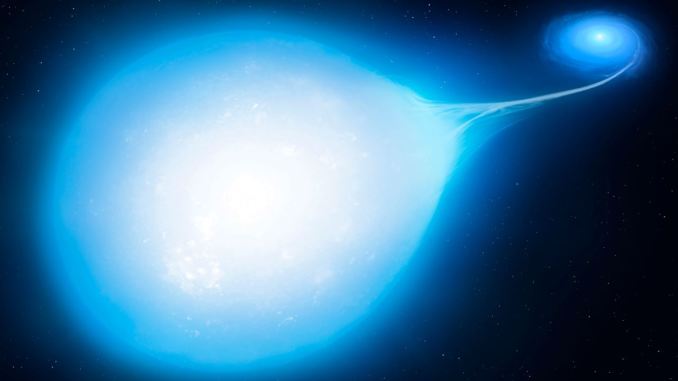A team of researchers, publishing the results of their studies in the journal Nature Astronomy, has discovered a rare mixture of a white dwarf that distorts the gravity of a nearby star, a naturally larger hot secondary dwarf, by “sucking” its subject. When the two stars orbit each other, the white dwarf, with its greater mass and therefore greater gravitational force than the other, actually “eats” an entire star.
The HD265435 binary system will produce a massive explosion.
Researchers believe that this binary system, called HD265435, will result in a massive supernova, a giant explosion. The system is located approximately 1,500 meters from us, and the two stars orbit in relation to each other, resulting in a complete orbit in about 100 minutes.
An explosion that would affect this system is called a Type Ia supernova. A Type Ia supernova typically occurs when a white dwarf gains the mass needed to reach 1.4 times the mass of the Sun (Chandrasekhar limit). This mass can be reached by obtaining material from one or more nearby stars. As soon as it obtains this mass, a thermonuclear reaction is triggered, and then an explosion.
A white dwarf will be able to gain the necessary mass in two ways
Ingrid Bellisoli, a researcher in the Department of Physics at the University of Warwick and lead author of the study, explains that we actually know very little about this type of supernova, but we do know that they exist because they have been discovered repeatedly in the most remote regions of the universe.
According to the researcher, the HD265435 system will end in a final explosion of this type, and this may happen in several ways. The white dwarf can accumulate the necessary substance, gradually taking it from the hot sub-dwarf. We can also see the two bodies get closer until they merge. In all cases, the white dwarf gains the mass necessary to explode into a Type Ia supernova.
Only a white dwarf is inferred
In fact, researchers using NASA’s TESS Space Telescope have only observed the hot sub-dwarf, because the white dwarf is too small to detect and so close to the sub-dwarf, which is much brighter. However, they deduced the existence of the white dwarf because they noticed that the brightness level of this system changes over time. They analyzed this change in brightness and also deduced from it the distorted shape of the sub-dwarf caused by the massive gravitational force of the white dwarf. The star has taken the form of a very special “drop”.
Finally, by making other types of measurements such as radial velocity and rotational velocity, the researchers also deduced the mass of the white dwarf, which should be similar to the mass of our Sun (but the body’s circumference is smaller than the radius of Earth).
The eruption is expected to occur within 70 million years.
Scientists calculate that the system, taking into account the mass of the sub-dwarf and the mass of the white dwarf, has the mass necessary for a Type Ia supernova to occur. In addition, the two stars are very close, so the researchers concluded that the explosion could occur in about 70 million years. They also calculate that the sub-dwarf, before merging with the white dwarf and after giving up much of its matter, will also become a white dwarf for a short time before the final, massive explosion.
The speed of the universe’s expansion: This discovery may be useful
The discovery of HD265435 may be useful in unraveling the mystery associated with the speed of the universe’s expansion because Type Ia supernovae, also called “standard candles,” with their very high luminosity level, are used to calculate the distance very accurately. from galaxies. So far, there is some inconsistency between the different estimates made by scientists regarding the speed of the expansion of the universe.
“The more we understand the formation of supernovae, the better we will be able to determine whether the discrepancy we see is caused by new physics that we are not aware of and taking into account, or simply because we underestimate it. With these distances, Pelisoli explains.

“Proud thinker. Tv fanatic. Communicator. Evil student. Food junkie. Passionate coffee geek. Award-winning alcohol advocate.”


